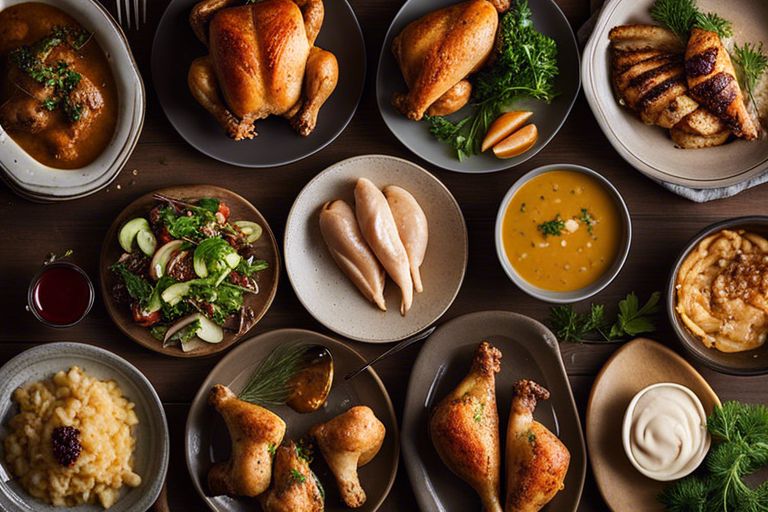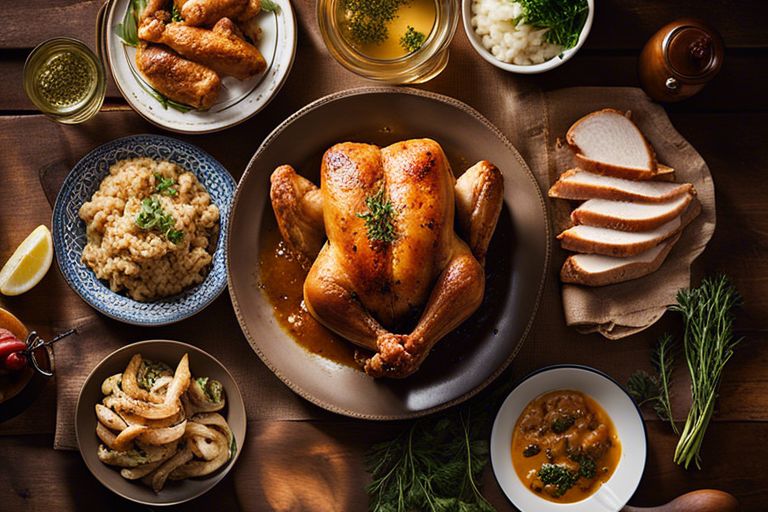Chicken, a versatile and popular protein choice, comes in various breeds that can impact the taste and quality of your dishes. When choosing the best chicken for your meals, you’ll want to consider factors like flavor, texture, and overall cooking experience. To learn more about different chicken breeds and their taste profiles, you can explore this insightful article on Raising Backyard Chickens: Real Taste & Best Breeds.

Key Takeaways:
- Free-range chicken: Comes from chickens that are allowed to roam outdoors, leading to better flavor and texture compared to conventional chicken.
- Organic chicken: Raised without antibiotics or hormones, offering a healthier option for those concerned about chemicals in their food.
- Heritage chicken: Known for their superior taste and texture, heritage chickens are a premium choice for food enthusiasts looking for a unique culinary experience.
Defining the Best Chicken for Food
While choosing the best chicken for your meals, there are several factors to consider to ensure you are making the right choice.
Factors to Consider
- Origin of the chicken: Locally sourced chickens may be fresher and have a smaller carbon footprint.
- Organic vs. conventional: Organic chickens are raised without antibiotics and have access to outdoor spaces, resulting in a more natural lifestyle.
- Chicken breed: Some breeds are known for their flavor and texture, so it’s worth exploring different options.
Knowing these factors can help you select a chicken that aligns with your values and preferences.
Nutritional Value
To ensure you are getting the best nutritional value from your chicken, look for options that are high in protein and low in unhealthy fats. Organic chickens may have higher levels of omega-3 fatty acids and other beneficial nutrients due to their natural diet.
Value the nutritional content of the chicken you consume, as it can contribute to your overall health and well-being.
Taste and Texture
To enjoy the best culinary experience, consider the taste and texture of the chicken you choose. Some people prefer the leaner meat of certain breeds, while others enjoy the juiciness of others. Experiment with different options to find your favorite.
Texture plays a crucial role in your dining experience, as it can greatly impact the overall enjoyment of your meal.
Chicken can be a versatile and delicious addition to your diet, providing vital nutrients and flavors that can elevate your meals. By considering factors such as origin, nutrition, taste, and texture, you can select the best chicken for your culinary creations.
Breeds for Meat Production
Broilers vs. Layers
One of the first things you need to understand when it comes to choosing the best chicken for meat production is the difference between broilers and layers. Broilers are specifically bred for their meat production, growing quickly to reach a desirable weight for consumption. On the other hand, layers are bred for egg production. While you can certainly eat a layer chicken, their meat might be tougher and less flavorful compared to broilers.
Heritage Breeds
Heritage breeds are traditional breeds that have been raised for centuries. These chickens are known for their flavorful meat and ability to forage and live off the land. They grow at a slower pace compared to modern broiler breeds but offer a richer flavor and more dense texture in their meat.
The raising of heritage breeds is valued for preserving genetic diversity and maintaining the cultural heritage associated with these breeds. By choosing heritage breeds for meat production, you are not only enjoying delicious meat but also playing a role in sustainable agriculture practices.
Popular Commercial Breeds
Popular commercial breeds, such as Cornish Cross, are bred specifically for meat production in large-scale operations. These chickens grow rapidly and efficiently convert feed into meat, making them a popular choice for commercial meat production. The Cornish Cross, for example, is known for its tender and juicy meat, making it a favorite among consumers.
When you opt for popular commercial breeds for meat production, you can expect a consistent product that meets the demands of the market. These breeds have been fine-tuned over generations to produce meat that is succulent, flavorful, and well-suited for various cooking methods.

Raising Methods Matter
Free-Range vs. Confinement
To ensure the best quality chicken for your table, it’s crucial to consider the raising methods. Free-range chickens have access to outdoor spaces, allowing them to engage in natural behaviors like scratching, pecking, and foraging for insects. This freedom of movement and varied diet often results in richer flavored meat compared to conventionally raised chickens kept in crowded confinement.
Organic vs. Conventional
The distinction between organic and conventional chicken lies in the feed and farming practices. Organic chickens are raised without antibiotics or synthetic pesticides, and their feed is non-GMO and free from chemical additives. This translates to healthier, more nutritious meat for you and your family, as you can be assured that the chicken was raised in a more natural and sustainable manner.
The higher cost of organic chicken reflects the additional care and quality of the raising practices. While conventional chicken may be more affordable, it’s important to consider the potential health benefits of choosing organic for your meals.
Pasture-Raised Chickens
Regarding pasture-raised chickens, the focus is on providing ample space for the birds to roam and forage on a natural diet. This results in chicken meat that is not only flavorful but also higher in key nutrients like omega-3 fatty acids. The chickens are healthier and happier due to their access to fresh air, sunlight, and a diverse diet.
Confinement of chickens in small spaces can lead to stress and unhealthy living conditions, affecting the quality of the meat. By opting for pasture-raised chicken, you are supporting more humane and sustainable farming practices, resulting in a superior product for your meals.
When raising chickens for food, the methods used can greatly impact the taste, nutritional value, and overall quality of the meat. By choosing free-range, organic, or pasture-raised chicken, you are not only investing in your health but also in supporting ethical and sustainable practices in the food industry. Consider the quality of the chicken you consume, as it can make a difference in your culinary experience and well-being.
The Role of Feed in Chicken Quality
Keep The 7 Best Meat Chickens for Your Homestead in mind when considering the best chicken for food. The feed that chickens consume plays a crucial role in determining their overall quality. Whether they are raised on grains or forages can significantly impact the taste, texture, and nutritional value of the meat.
Grains vs. Forages
Feed is an imperative factor in poultry farming. Chickens raised on a diet high in grains tend to have a milder flavor and softer texture compared to those that forage for their food. Foraging allows chickens to consume a more diverse range of nutrients, which can result in richer and more flavorful meat. While grains can provide imperative nutrients, incorporating forages into the chicken’s diet can enhance the overall quality of the meat.
Antibiotics and Hormones
Hormones play a significant role in the growth and development of chickens. Some poultry farmers may use hormones to accelerate growth and increase the size of the chickens. However, the use of hormones in poultry farming is a controversial topic, as it can have potential health implications for consumers. It is imperative to be mindful of the source of your chicken and opt for hormone-free options whenever possible.
Antibiotics are another common addition to chicken feed. While antibiotics can help prevent diseases in chickens, overuse of these drugs can lead to antibiotic resistance and pose health risks to consumers. Choosing chicken products that are raised without antibiotics can help reduce the overall intake of these drugs and promote healthier eating habits.
Omega-3 Enriched Feed
Hormones play a lesser role compared to the type of feed when it comes to chicken quality. Omega-3 enriched feed can significantly impact the nutritional profile of chicken meat. Chickens that are fed with omega-3 enriched diets tend to have higher levels of healthy fats, which can benefit your health when consumed. Including omega-3 enriched chicken in your diet can be a great way to boost your intake of imperative fatty acids.
With these factors in mind, you can make informed choices when selecting the best chicken for your meals. Opting for chickens raised on a diverse diet of forages, free of hormones and antibiotics, and fed with omega-3 enriched feed can help you enjoy high-quality and nutritious chicken on your table.
Regional and Cultural Variations
Your culinary journey across the globe will reveal a plethora of chicken dishes that reflect various regional and cultural preferences. Each culture has its unique way of preparing and enjoying chicken, leading to a diverse range of flavors and cooking techniques.
American Favorites
Cultural influences play a significant role in shaping American chicken classics. From Southern fried chicken to barbecue wings, the United States boasts a wide array of beloved chicken dishes that have become staples in homes and restaurants across the country. These dishes often highlight the fusion of different cooking styles and ingredients, resulting in mouthwatering creations that appeal to a wide audience.
European Traditions
European countries have their own rich chicken traditions, with recipes that have been passed down through generations. In France, coq au vin is a popular dish that combines chicken with red wine, mushrooms, and garlic for a hearty and flavorful meal. Meanwhile, in Italy, chicken cacciatore showcases the country’s love for rustic, tomato-based dishes that are bursting with herbs and spices.
Traditions play a crucial role in European chicken dishes, with many recipes dating back centuries and holding a special place in the hearts of locals. Whether it’s a comforting British chicken pie or a Spanish chicken paella, these dishes tell stories of culinary heritage and regional pride.
Asian-Style Chicken
Chicken takes on a whole new dimension in Asian cuisine, where bold flavors and intricate cooking techniques reign supreme. From Chinese sesame chicken to Thai green curry chicken, Asian-inspired dishes are a feast for the senses, combining sweet, savory, spicy, and tangy elements in perfect harmony.
It’s no surprise that Asian-style chicken dishes have gained popularity worldwide, thanks to their explosive flavors and diverse textures that keep you coming back for more. Whether you’re indulging in crispy Korean fried chicken or savoring a comforting bowl of Japanese chicken ramen, the depth of flavors in Asian chicken cuisine is sure to leave a lasting impression on your taste buds.
Cooking Methods to Enhance Flavor
Grilling and Roasting
Flavor is key when cooking chicken, and one of the best ways to enhance it is through grilling and roasting. These methods help seal in juices and create a delicious crispy exterior that locks in the natural flavors of the chicken. When grilling, you can infuse your chicken with smoky goodness by using wood chips or charcoal. Roasting in the oven allows for even cooking and caramelization of the skin, resulting in a rich and savory taste.
Braising and Stewing
Flavor is further intensified through braising and stewing. These techniques involve cooking chicken slowly in flavorful liquids like broth, wine, or sauces, allowing the meat to become tender and soak up all the delicious seasonings. Braising involves searing the chicken first to lock in juices, then simmering it in liquid, while stewing involves cooking the chicken entirely submerged in liquid to create a succulent and flavorful dish.
To achieve maximum tenderness and depth of flavor, chicken should be cooked at a low temperature over a longer period when braising and stewing. This slow cooking process breaks down the connective tissues in the meat, resulting in moist and tender chicken that is rich in flavor.
Pan-Frying and Searing
The quick and intense heat of pan-frying and searing is another fantastic way to enhance the flavor of chicken. By browning the exterior of the chicken in a hot pan with oil, you create a caramelized crust that adds depth and complexity to the taste. Pan-frying and searing also help lock in the juices, keeping the chicken moist and flavorful.
This method is great for when you want to quickly cook chicken while still achieving a crispy and golden-brown crust. Searing the chicken first on high heat and finishing it in the oven ensures that you get a juicy and flavorful chicken with a beautiful exterior.
To wrap up
Considering all points, when it comes to choosing the best chicken for food, it ultimately boils down to personal preference and priorities. Whether you prioritize taste, texture, ethical concerns, or cost, there are various options available to suit your needs. Free-range chicken offers a more natural environment for the birds, resulting in potentially better-tasting meat, while organic chicken ensures they are raised without antibiotics or hormones. On the other hand, conventional chicken may be more affordable but comes with potential ethical and health considerations.
Ultimately, the best chicken for food is the one that aligns with your values and tastes the best to you. By being mindful of where your food comes from and how it’s raised, you can make an informed decision that not only benefits you but also supports sustainable and ethical practices in the food industry.
FAQ
Q: What factors should I consider when choosing the best chicken for food?
A: When choosing the best chicken for food, consider factors such as the breed of chicken, its diet, how it was raised (organic, free-range, etc.), and the cooking method you plan to use.
Q: What is the best breed of chicken for food?
A: The best breed of chicken for food depends on personal preference and the desired end result. Popular breeds known for their meat quality include Cornish Cross, Red Ranger, and Freedom Ranger.
Q: How does the chicken’s diet affect its taste and quality as food?
A: A chicken’s diet can greatly affect its taste and quality as food. Chickens that are fed a varied diet with plenty of nutrients tend to have better flavor and texture compared to those fed with low-quality feed.



